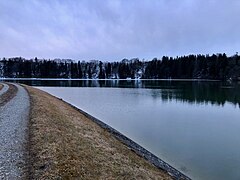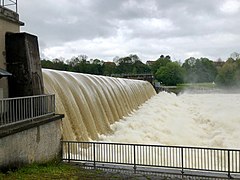Lech level 10 - Epfach
| Lech level 10 - Epfach | |||||||||||
|---|---|---|---|---|---|---|---|---|---|---|---|
| View of the Lech barrage 10 | |||||||||||
|
|||||||||||
|
|
|||||||||||
| Coordinates | 47 ° 54 '31 " N , 10 ° 54' 46" E | ||||||||||
| Data on the structure | |||||||||||
| Lock type: | Run-of-river power plant | ||||||||||
| Construction time: | ? –1948 | ||||||||||
| Power plant output: | 8.3 MW | ||||||||||
| Operator: | E.ON hydropower | ||||||||||
The Lech barrage 10 - Epfach is a barrage of the Lech between Schongau and Landsberg and lies at the level of the village of Epfach, which belongs to the municipality of Denklingen .
history
As early as 1938, the expansion of hydropower in Bavaria was planned for the first time by the German Reich and the State of Bavaria . While Bayernwerk AG initially planned the construction of conventional run-of-river power plants , the head of the Supreme Building Authority in the State Ministry of the Interior, Arno Fischer , was able to carry out the expansion on the basis of the underwater construction method he developed according to the "Schwede-Coburg-Fischer" system with the help of his party friend Franz Schwede -Coburg and the NSDAP prevail.
Bayerische Wasserkraft AG, or BAWAG for short, was founded on January 26, 1940 to expand the power plants. A third of the share capital each belonged to the state of Bavaria, RWE and VIAG .
Initially, Arno Fischer planned to complete twenty barrages by 1942, but construction began in the summer of 1940 initially at six locations (Lech barrages 9 , 11 , 12 , 13 , 14 , 15 ).
Field railways and access roads were created for the transport of materials . First, sheet pile walls were erected around the area of the later power plant buildings, after which the gravel bed of the Lech within the excavation pit was removed down to the bedrock. Then the shuttering work for the concrete and reinforced concrete began, the hammering in of the sheet piling for the dams , the concreting of the dam base and the rest of the embankment.
In 1943 levels 11, 12, 13 and 15 were connected to the grid, levels 9 and 14 followed in 1944. Levels 7 , 8 and 10 of the same design were not completed until after the Second World War 1947–1950.
In 1994 all of the power plants came to VIAG, in 2000 to E.ON and finally in 2016 to Uniper Kraftwerke .
The power plant's concession runs until 2039.
technology
The generated output of Lech barrage 10 is 8.3 MW with a drop height of 8.5 meters.
In the " Arno Fischer power plant construction " weir and power plant form a common structure, the weir flap has 8 attached flaps with a total width of 76 m, four bottom outlets and an engine room integrated in the weir .
Within the power plant are nacelle cranes with which all removable parts of the plant can be promoted to the border area, this large loading gate was installed on one side in all power plants.
The power plant has six Strafloturbines and six machine sets.
Each turbine has a flap in the inlet area and a contactor in the outlet area. These locking mechanisms make it possible to dry the turbines individually for inspection purposes and to walk through them. A total of four lower-lying bottom outlets are arranged between the six turbine sets in order to divert the sediment transported during floods safely into the underwater .
The generator itself is arranged as an external ring generator , the rotor is firmly connected to the impeller . However, the problem here is the sealing of the turbines from the generators, as well as the practical impossibility of adjusting the impeller. Rigid propeller impellers are therefore installed in the Arno Fischer design. In principle, this limits the efficiency in the partial load range, but the poor partial load efficiency of the propeller turbines can be compensated relatively well by staggering the machines in operation.
The expansion flow of the power plant is 120 m³ / s, the standard energy 40,726 MWh per year.
See also: List of hydropower plants in Germany
gallery
Individual evidence
- ↑ Martin Gschwandtner: Once upon a time there was a «coal theft» technology under the yoke of the Nazi dictatorship; Arno Fischer and the wrong track of the “underwater power plants” in the period between 1933 and 1945 . GRIN, Munich 2009.
- ↑ Bayerische Wasserkraftwerke Aktiengesellschaft (ed.): 50 years of nature and energy in harmony, 1940-1990 . Munich 1990.
- ↑ Bayerische Wasserkraft AG: The Lech and the Lech expansion . Munich 1988.
- ^ Bavarian State Office for Water Management: 100 years of hydraulic engineering on the Lech . tape 19 . Munich 1984, p. 58 .
- ↑ Gerald Modlinger: The Lech should be wild. In: Landsberger Tagblatt. August 7, 2019, accessed November 4, 2019 .
- ↑ Anton Lichtenstern, Thomas Wunder: The steam hammer worked day and night. September 5, 2015, accessed February 13, 2019 .
- ^ Canaan: The underwater power plant . 1945.
- ↑ Andreas Ringler: Floodable river power plants. (PDF) 2016, accessed February 13, 2019 .
- ↑ Analysis of the use of hydropower in Bavaria. (PDF) Retrieved January 19, 2019 .





